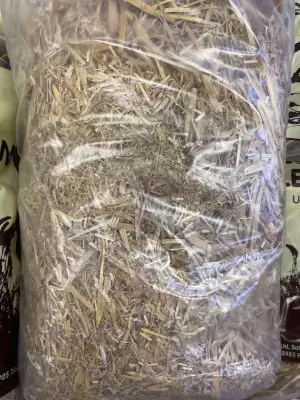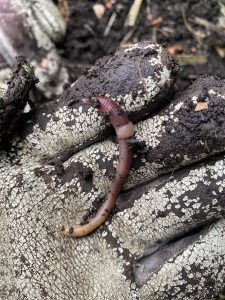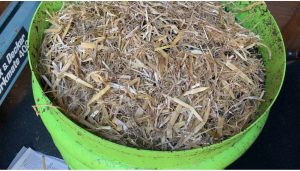I started my worm bin in February when it was bought for me as a gift – the temperatures were -4 degrees Celsius. I researched frantically but a few worms died because my knowledge was limited. You’ll read various information about keeping composting worms warm in winter. What you do depends on which country you live in and which part of your own country, as temperatures vary. There are methods you can use to keep worms warm inside their worm bin, and keeping the bin insulated whether stored indoors or outdoors.
You’ll find a wealth of information on YouTube, including my playlist, The Worm Gang. My bin is the Ferme du Moutta, which is predominantly a wheel-stacking system. In 2024, I’ll start a worm bin using a plastic tub, making it more affordable during the current economic climate if you want to compost your food scraps. If your worm bin sits on the floor, it’s vital to provide ground insulation to prevent the cold from penetrating.
Do compost worms freeze in Winter?
Yes, worms can freeze in winter. So, how cold is too cold for composting worms?
Composting worm activity tends to slow down when temperatures drop below 10 degrees Celsius. Below 4 degrees Celsius, the cold can even be fatal for the worms. That’s why planning insulation for your bin before winter arrives is crucial—insulating the exterior and interior, or providing shelter.
As the temperature decreases, you’ll notice your worms moving slower. In mid-November 2023, my worms were still active even though the temperatures hadn’t consistently dropped. However, they’ll burrow deeper as it gets colder to find the warmest spots in the bin.
Worms don’t hibernate. And, composting worms cannot regulate their body temperature because they are cold-blooded. Decomposing food in the bin creates some warmth for them. But overall, it’s essential to limit your composting setup’s exposure to harsh weather conditions to keep your worms thriving and protect them from the cold.
Follow The Worm Gang on YouTube
What types of worms are suitable for a compost bin?
Earthworms (garden worms) are not designed for worm bins because they cannot tolerate the conditions, so you’ll need to invest in specialised worms. Composting worms love decaying food and live happily amongst food waste and near to the top surface of the soil.
My step-Dad bought me 500g composting worms from Vermicuilte Farm in France, which included three types. Unfortunately, it doesn’t name the breed, but below are two recommended types.
Red Tiger worms – known as the branding worm, manure worm or Red Wigglers. These worms are smaller than the European Nightcrawler. They can be identified as having stripes and red.
European Nightcrawler – these are recognisable as the largest worms with a reddish brown body combined with yellowy strips and cream tip. They can tolerate damper conditions and soil with acid but, do not take advantage and feed these worms scraps containing too much acidic content. Some composters feed worms citrus peel in small amounts, but I prefer not, too.
Adding a specialised lime mix every two weeks can stop acid content building up, stop a smelly bin, and keep a healthy wormery by balancing the pH level. I purchased a bag of lime from Wiggly Wigglers and can offer you £2.50 off your first order using my link.
Insulation techniques to keep your worms warm

My worm bin was active from February 2023. I lived along the coast in Yorkshire, where temperatures dropped to as low as -4 degrees Celsius. Most of my worms survived the chilly weather, but unfortunately, a couple of them tried to explore and ended up freezing on the cold ground after escaping the bin.
Storing your worm bin outdoor – I positioned my wormery snugly in a corner by the house for shelter. Our road led straight to the beach, making our garden a wind tunnel. It’s essential to place your bin in an area shielded by buildings, fences, or even a log shed to protect it from harsh bitter winds.
The Ferme Du Moutta has wheels on the base, so its base doesn’t touch the ground. If your bin doesn’t have this feature, you can elevate it on bricks, slabs, wood, or even packaging polystyrene in a sheltered part of your garden. This helps prevent it from sitting directly on the cold ground.
Insulation ideas:
- Gather fallen leaves and place them beneath and around the bin as much as possible
- Cover the bin with a piece of old carpet – don’t forget rain will absorb into the carpet
- Bubblewrap from Poundland can be used around the exterior
- Place the bin between straw bales
Storing your worm bin indoors – During winter, it’s best to keep your worm bin in an outbuilding, garage, or shed if facilities are available. Remember to lift the bin off the chilly floor. An old blanket works great as a cover—check out local charity shops for affordable options.
Keeping worms warm inside the bin – People have various methods to keep their worms warm in the bin. I’ve opted to add straw to each tray; a bag of straw costs £1.39 from QD Stores. I haven’t covered the bin with anything yet, especially since the worms in the Ferme Du Moutta made it through last winter outside—I’m confident they’ll do well this year, too. If you’re looking for extra insulation, consider adding natural materials like leaves, or a wormery coir mat, an old jumper or a carpet on top of food. Coir mats can be purchased from Amazon, but you’ll find many options by searching on Google.
Troubleshooting cold weather challenges for a worm bin
Never block off ventilation holes – your worms need air and will suffocate without.
Continue feeding – worm activity will slow so add less food, but don’t forget to feed them. However, too much uneaten food may rot and create too much moisture. Don’t forget that a lime can reduce smelly smells in a worm bin.
Winter often brings more consumption of veggies for us, which means an increase in food waste during these colder months. I use Bokashi bins to handle this surplus and food that is toxic to worms. Since worms tend to eat less in winter, the Bokashi bin helps manage the bulk of the food waste during this season.
Follow my Bokashi playlist on YouTube. Bokashi bins can be expensive, but I found an affordable duo set on Etsy so the playlist includes me assembling them.
Harvesting for castings – remember that if you harvest during the winter, you’ll expose the worms to freezing temperatures, and that can harm them.
Ignoring your bin through the winter months – no doubt they will survive, but always monitor them. Drain off liquid too.
Ensuring enough bedding depth in the bin – your worms will burrow and seek the warmest part of the bin. I will continue monitoring my worms to see which bin they frequent the most.
Reproduction process in Winter

It’s exciting how reproduction continues during winter. In fact, worms reproduce every 3 to 4 days! Today, when I aerated the trays to give them more oxygen, I noticed some pregnant worms. You can tell because they have a raised ring around their bodies.
You can recognise cocoons as small yellow balls on the bedding. As they develop, they change to a maroon colour just before they hatch.
From cocoon to baby worm, it takes about three weeks. By the end of winter, your worm population will likely grow, maybe even enough to start another bin. Just keep in mind, worms live relatively short lives—only about 2 to 3 years—so their reproduction is crucial for the colony’s continuity.
Related questions
How do you start a worm bin?
Plenty of bins are available on Amazon, including my Ferme Du Moutta but prices vary. DIY plans or small worm bins are available on Etsy, which you can read in my article about lower-priced options. Alternatively, you can make your own using a plastic tub and the outlay is a tub and worms – there are plenty of videos on YouTube, including on The Worm Gang. My article gives initial guidance about starting your first wormery and is based on my experience.
Key takeaways
- You’ll find items at home or in the charity shop to insulate the worms
- Providing warmth inside and outside the box can help them survive the winter
- Use garden materials to raise the bin off the cold floor
- Make use of Bokashi bins during the winter
- Worms will reproduce to save you buying more
Poppys Pets is a participant in Awin and Amazon Associate affiliate programs which compensates me for referring traffic. It is of no extra cost to you and if thinking of buying a product, please consider using my link. It\'ll earn Poppy\'s Pets a few pennies to continue to this website. Only a selection of articles and videos on this website and YouTube channel contains affiliate links. Further information: Disclaimer and Privacy Policy
I own the Ferme Du Moutta and Bokashi bins and frequently compost


